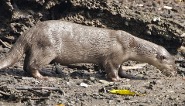 The Smooth-coated Otter (Lutrogale perspicillata) is the only surviving representative of the Lutrogale family. As its name would suggest, the skin of the smooth-coated otter is shorter and smoother than that of other otters. While there is a small population that can be found in Iraq, this creature is more commonly found in India and to the east into Southeast Asia.
The Smooth-coated Otter (Lutrogale perspicillata) is the only surviving representative of the Lutrogale family. As its name would suggest, the skin of the smooth-coated otter is shorter and smoother than that of other otters. While there is a small population that can be found in Iraq, this creature is more commonly found in India and to the east into Southeast Asia.The smooth-coated otter is the largest otter in Southeast Asia. Adults can grow up to about 1.3 meters or 51 inches and weigh from 7 to 11 kilograms or 15.4 to 24.2 pounds. Not only do these otters have a smoother and shorter coat than other otters, but they also have a more rounded head and a nose that is hairless and shaped like a deformed diamond. Their tail is also flat, which is different than the rounded tails found on other otters, and can make up about 60 percent of their body length. Like others in their species, they also have strong paws with sharp claws and webbed toes. On its back, the smooth-coated otter is light to dark brown in color while being light brown to almost gray underneath.
While these otters can usually be found in areas where there is lots of water, they are also comfortable on land and have been know to travel across long distances of land in order to find a suitable habitat.
The smooth-coated otter falls under the conservation status of a vulnerable species due to the shrinking wetland habitats, pesticide contamination of waterways, and poaching. It is listed as an endangered species in India and is now protected under the Wildlife Protection Act.
While the smooth-coated otter's diet mainly consists of fish, which they frequently hunt in groups, they also consume insects, reptiles, earthworms, birds, rodents, crustaceans, and frogs. The main predators that these otters must be wary of are crocodiles and species of medium sized cats. Large birds of prey have also been known to be a threat, mostly to younger otters. Man is also considered a predator of this creature, as poachers hunt them for their fur.
Picture of the smooth-coated otter by Lip Kee Yap from Singapore, licensed under the Creative Commons Attribution-Share Alike 2.0 Generic license.
The Indian smooth-coated otter, smooth-coated otter is listed as Vulnerable (VU), considered to be facing a high risk of extinction in the wild, on the IUCN Red List of Threatened Species
Namings for the smoothcoated otter
A young / baby of a smoothcoated otter is called a 'pup or whelp'. A smoothcoated otter group is called a 'romp, bevy, lodge, family or raft'.Countries
Bhutan, Brunei, Burma, Cambodia, China, India, Indonesia, Iraq, Laos, Malaysia, Nepal, Pakistan, Thailand and VietnamSmooth-coated otter habitats
Artificial / Aquatic & Marine, Artificial / Aquatic - Aquaculture Ponds, Artificial / Aquatic - Canals and Drainage Channels, Ditches, Artificial / Aquatic - Irrigated Land (includes irrigation channels), Artificial / Aquatic - Ponds (below 8ha), Artificial / Aquatic - Seasonally Flooded Agricultural Land, Artificial / Aquatic - Wastewater Treatment Areas, Artificial / Aquatic - Water Storage Areas (over 8ha), Bogs, Marshes, Swamps, Fens, Peatlands, Coastal Brackish / Saline Lagoons / Marine Lakes, Coastal Freshwater Lakes, Estuaries, Forest, Freshwater Springs and Oases, Grassland, Marine Coastal / Supratidal, Marine Intertidal, Marine Neritic, Mud Flats and Salt Flats, Pelagic, Permanent Freshwater Lakes (over 8ha), Permanent Freshwater Marshes / Pools (under 8ha), Permanent Inland Deltas, Permanent Rivers / Streams / Creeks (includes waterfalls), Permanent Saline, Brackish or Alkaline Lakes, Permanent Saline, Brackish or Alkaline Marshes / Pools, Rocky Shoreline, Salt Marshes (Emergent Grasses), Sandy Shoreline and / or Beaches, Sand Bars, Spits, Etc, Seasonal / Intermittent Freshwater Lakes (over 8ha), Seasonal / Intermittent Freshwater Marshes / Pools (under 8ha), Seasonal / Intermittent Saline, Brackish or Alkaline Lakes and Flats, Seasonal / Intermittent Saline, Brackish or Alkaline Marshes / Pools, Seasonal / Intermittent / Irregular Rivers / Streams / Creeks, Shrub Dominated Wetlands, Subtropical / Tropical Mangrove Vegetation Above High Tide Level, Subtropical / Tropical Moist Lowland, Subtropical / Tropical Moist Montane, Subtropical / Tropical Seasonally Wet / Flooded Grassland, Subtropical / Tropical Swamp and Wetlands (inland)Some facts about the
Smooth-coated otter
Adult weight : 9 kg (19.8 lbs)
Gestation : 63 days
Litter size : 5

Custom Search